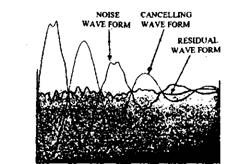30.10.
Adaptive Noise Control
The principle of adaptive noise control is to cancel out the original source of noise by using sound, which is identical and 180 degrees out of phase, or in anti-phase. Figure 30.60 shows three signals, the original noise, the anti-phase cancelling waveform and the residual noise. Figure 30.61 demonstrates the method used where the original noise is picked up by a microphone, inverted and amplified, and then replayed by a suitably located speaker. This effectively cancels out the noise.
While the theory is relatively simple, until recently it has not been suitable particularly for motor vehicle use. This is because the wide range of noise frequencies produced need fast

Fig. 30.60. Three signals, the original noise, the anti-phase cancelling waveform and the residual noise.

Fig. 30.61. Layout of an adaptrive noise control system.
response time to deliver acceptable result. Low frequency noise (< 200 Hz), causes boom in a vehicle, and hence it becomes very difficult to reduce by conventional methods.
30.10.1.
An Overview of Available Systems.
The techniques used for reducing cabin noise levels can range from the use of simple sound-deadening material to special design of engine mountings, exhaust systems and the use of balance shafts on the engine. However there is still a demand to reduce noise further, which is becoming ever more expansive.
Today most vehicles are susceptible to some low frequency boom in the passenger compartment, even after the use of a large amount of sound deadening. The trend of producing lighter vehicles using thinner grade metal further exacerbates the problem. Conventional techniques solve the problem at certain frequencies, but not cover the complete range.
The adaptive noise control system requires a high speed digital signal processor and also a detailed understanding of noise generation dynamics in the vehicle. A typical four cylinder engine running between 600 and 6000 rpm has a firing frequency of about 20 to 200 Hz. There are several critical speeds at which the vehicle displays unpleasant boom. Considerable low frequency noise is also generated by low profile tyres and harder suspension.
The system developed by Lotus Engineering uses eight microphones embedded in the vehicle headlining to sample the noise. A digital signal processor measures the average sound pressure energy across the cabin and adjusts the phase and amplitude of the anti-noise signals. These are played through the in-car speaker system until, through measuring the error signal from the microphones, a minimum noise is achieved. The maximum active noise control can be achieved in about 70 ms. A quality loudspeaker system is necessary, which is capable of producing up to 40 W RMS per channel. This is not uncommon on may ICE systems. A typical layout of an adaptive noise control system is shown is Fig. 30.61. The greatest improvements are achieved in small vehicles, where the perceived reduction is as much as 80%.
Another technology to adaptive noise control, developed by Lotus Engineering, is a hydraulic engine mount controlled electronically in response to the engine vibration. Some manufacturers are now having a much simpler version, capable of switching between hard and soft settings. The Lotus system is claimed to be as effective as about 45 kg of sound deadening material. Walker, an exhaust manifold company, has developed an active muffler for reducing exhaust noise (Fig. 30.62), which uses a digital processor. Two inputs are used; a microphone to measure the noise from the tail pipe and an engine speed sensor. The system calculates the correct anti-noise and delivers this by means of special speaker drivers mounted on the exhaust system. The residual noise is measured and adjustments are made. Since the system is self-learning it can adopt to the changing noises of an aging engine.

Fig. 30.62. Active exhausts noise reduction.

Fig. 30.63. Principle of radar as a reversing aid.
After the catalytic converter, the active muffler allows straight gas flow from the exhaust. This improves engine performance that means less fuel is used. Through this arrangement, an average reduction in fuel consumption of 5% is possible. Future exhaust control directives are expected relating to exhaust noise and the maximum currently set is at 77 dB (A) in Germany. Larger mufflers will be needed to comply with more stringent regulations.
